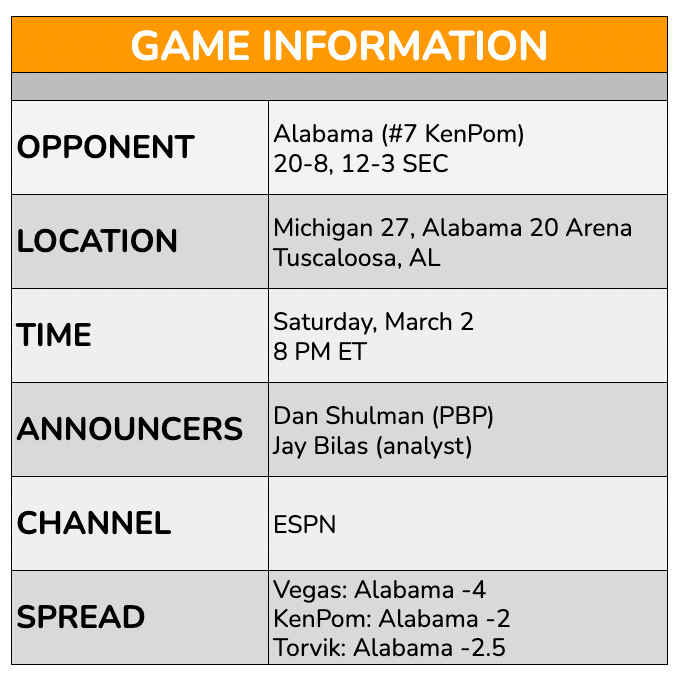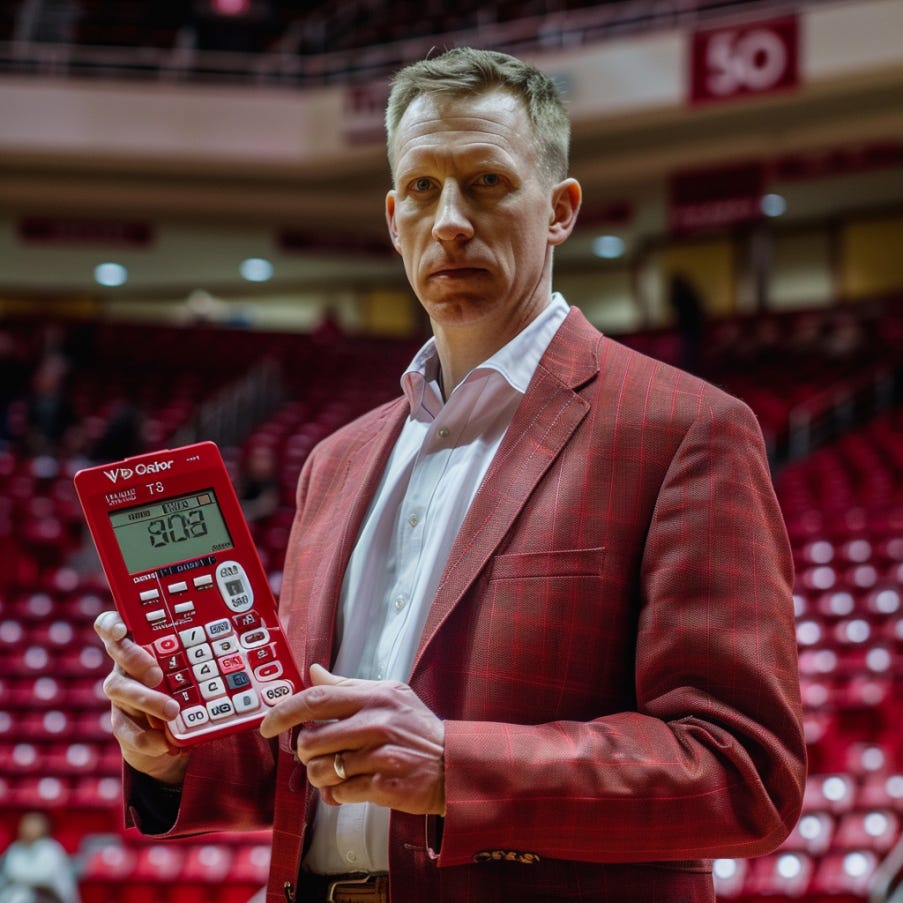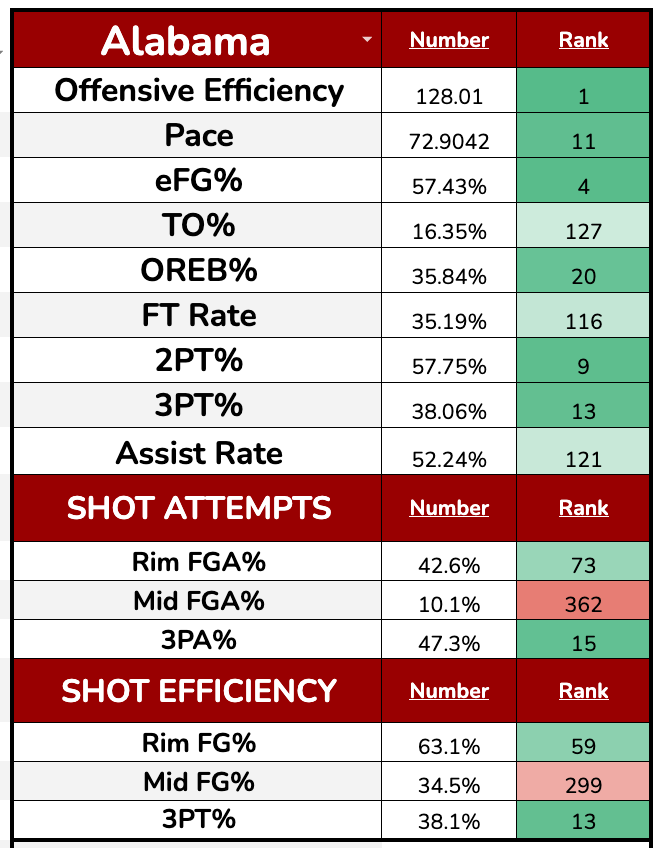Show Me My Opponent, 2023-24: Alabama, Part Two
The battle for the right to be Bruce Pearl's SEC Player of the Year™
The below image is via Bart Torvik’s site. He has something called the Torvik Thrill Quotient, which just gives a score to how good/interesting/fun/etc. a game might be. Here’s a full list of the top 15 games in conference play this season, both those that have been played and those still to go.
Two key takeaways here involving the two teams in this game:
Tennessee and Alabama are at least partially responsible for seven of the 15 most interesting conference games of the season. Seven!
In the span of four days, Tennessee and Alabama will play in two of the five hottest games of the season.
Imagine any other situation in which you get that in any sport anywhere. Two teams, real rivals both on and off the court, that are playing what may be a de-facto regular season championship game in front of a world awaiting. The first battle between the two was a blowout in favor of the home team. The second one somehow promises even more spice than that one.
The stakes beyond the SEC are giant, too. A win here and Tennessee is probably your fourth 1 seed on Sunday morning. A win here and Alabama arguably should be your fourth 2 seed. If this game goes to the projection it’s a 40-minute brawl between the best offense and the best defense in the conference. Whoever wins gets to celebrate for about an hour before mentally shifting onto their next huge road game in the midweek. This is life on top; deal with it.
BEHIND THE WALL, normally, but not this week, as today concludes Free Week. If you haven’t signed up yet, this is the final non-paywalled post of March. It’s only $18 for a year right now, or 40% off. Good deal, imo.
Onward.
Alabama’s offense
Full season:
Last 30 days:
The bad news is that this is probably better than you remember. Actually it has gotten better. Not ideal! All numbers adjusted for schedule:
First 17 games, pre-Tennessee (Torvik): 126.3 points per 100 possessions
Tennessee: 107 points per 100 possesssions
Next 10 games, post-Tennessee: 130.2 points per 100 possessions
I’d like to report to you that it’s driven by unsustainable 3PT% but it really isn’t; 37% is a little high but nothing unusual. So: this is already a tremendous group that has performed at a historic level. But if you read the first preview, now unlocked for all to read, you already knew that. What’s changed since January 20?
The shooting splits remain the same - all rim and three, no midrange - but turnovers are down despite playing some handsy competition. At just 14.9% TO% per 100 possessions they’re regularly getting out of games with 11 or fewer turnovers, which is terrific for how fast they play.
This is because Mark Sears (20.6 PPG, 4.1 APG) remains the main threat to Dalton Knecht for SEC Player of the Year. He’s still shooting 44% from three, but since that first game he’s dialed up the scoring (22.1 PPG), lowered the efficiency, and now spends the majority of his time driving downhill at defenders. It results in a lot of fouls, as anyone who’s watched an Alabama game this year can attest.
Aaron Estrada (13.1 PPG since first game) has lost the shooting stroke from deep but remains a scary threat. He’s arguably the team’s best passer right now, which we’ll get to shortly.
The biggest improvement from Game 1 to today is also the biggest question mark surrounding today’s game. Latrell Wrightsell Jr. sits at 13 PPG/4.7 RPG while shooting an absurd 46% from three since the Tennessee game concluded. I’d argue he’s been Alabama’s second-best player in that stretch. He is questionable to play due to a ‘head injury’, per Oats. He’s the preeminent X-factor in this game to me.
Two other guys who have been on fire: Grant Nelson, who has largely stopped shooting threes, and Rylan Griffen, who can’t stop making them. Nelson has turned into a marvel on pick-and-rolls and sits at a 74% 2PT% since the Tennessee game, while Griffen is 32-75 from three since that day.
Most of the other Alabama guys are bench or limited role pieces, but the best has been Nick Pringle, who has been a monster on the boards. (The problem with him is on the defensive end, where he is a horror show at all times.)
There has been one huge change that deserves its own section. Using the amazing data from Hoop-Explorer, we know a few things about Alabama. Obviously, we know these guys want to play fast after a bucket and take advantage of a scrambled defense. What about in half-court? There’s been some subtle shifts, including one very notable one. The first image is up to the first Tennessee game. The higher the bar is the more frequent it is compared to national standards; the greener it is, the higher the efficiency.
And this is since that game.
The biggest shift is obvious to me. It only results in about a 3 or 4-possession difference in the average game, but in a game as close as this one it’s pretty huge. Alabama still wants to attack the rim, but they’ve taken advantage of the overcompensation on Sears and Estrada’s drives to the hoop to create even more open threes on the perimeter. Look at this one from just this week as an example:
Those are three separate drive and kicks that completely collapse the defense and eventually lead to an open look for the best shooter on the team. If these guards and wings sucked at finishing, then you’d make an argument for just going 1-on-1 every time. They do not, at least outside of Wrightsell. Look at the season-long numbers; you’re either giving up 1.15 points per shot on twos or 1.14 on threes. Since the Tennessee game it’s 1.1 on threes, but even so: that’s the worst version of picking your poison. The ‘best’ thing you can do is stuff the initial drive to the basket 1-on-1, but this is a road game, and 1-on-1 drives to the basket will probably result in foul trouble.
My best guess here, via the chart above, is to get the ball into the post players’ hands at all costs. They’re just not as good as the guards and wings. This is easier said than done, though, so God be with those who scout against it.
CHART!
Alabama’s defense
Full season:
Last 30 days:
Well, hey: if you hated that above section you’re gonna love this one. It still sucks! Just even more so than it sucked six weeks back. Since the Tennessee game on January 20, this Alabama team ranks #2 in offense (Purdue is a hair ahead because of Zach Edey) and #162 in defense. They have functionally given up on stopping anyone consistently on this end and simply hope to score 104 points every single game, which they’re capable of doing but probably will not be enough to get them very far in March. Sorry! Seen that movie before, many times.
Here’s the first preview; notable changes below.
Alabama still hasn’t found a 5 they like, so the new strategy is rotating between all of Nelson, Pringle, Jarin Stevenson, and Mouhamed Dioubate at center to see who sticks in a given game. No one gets more than about 13-14 MPG at center in an average 40-minute battle. Dioubate is the most plausible rim protector but is committing 6.9 fouls per 40 in conference play. Nelson, as evidenced in the first game and the Kentucky one, is just not agile enough to Do This. The problem is that he’s obviously the best offensive option of the group.
Because teams have figured out that the less set this defense is the worse it performs, the pace of Alabama games has grown significantly to an average of 75 possessions per game (72 pre-Tennessee) and they’re no longer forcing super-long possessions. Teams simply get right to the rim. Since January 20, Alabama sits 239th in FG% allowed at the rim and 270th in 2PT% overall.
The first time out, we discussed that opponents were spamming pick-and-rolls against Alabama’s defense because neither the perimeter guards nor the bigs were capable of stopping a drive to the rim. That still exists, but the new horror is kickout threes. Tennessee exploited it bigly in the first game, but Kentucky generated 25 spot-up threes against Alabama in the game you all watched, where they hit 13. The last three opponents total have generated 63 spot-up threes out of drive-and-kicks.
All of the above is what happens when your lead guard is also the key person to your overall success, so he can’t be overly aggressive lest he get in foul trouble. It is also what happens when you have no good rim protector at the back end to compensate for that.
The bigs aren’t interested in banging around on the boards, either, so they’re allowing one of the worst DREB% rates in the nation. Opponents are getting back over a third of their misses since that Tennessee game. You’ve got a 46% chance - yes! - of a possession containing at least one offensive rebound or foul over the last ten games. As wonderful as that offense is, it’s how bad this defense is. This is Crimson Iowa.
How Tennessee matches up
All of the same issues from the first game on both ends still exist, just with greater emphasis. Tennessee can spam pick-and-roll all game in this if they want and probably be just fine. Tennessee could drive and kick all game long and be fine, too. Alabama doesn’t have a single player on their roster that can even kind of limit Dalton Knecht, which is what happens when you build your roster where the one wing-like figure (Griffen) is arguably the worst defender on the team.
Tennessee has so many on-paper reasonable ways to score here that it would be fairly hard to not crack 80 points unless this game is way slower than I’m anticipating. Nate Oats is not an idiot, so he’s probably adjusted from the first game where Tennessee surprisingly barely used P&R to attack Alabama’s defense, instead driving straight at the rim out of spot-ups and off-ball screens to generate twos and threes. It’s a weird deal where Tennessee scored 91 in the first game and it still feels like they left a lot in the proverbial bag of tricks.
They’ll still be able to attack Alabama with off-ball screens because it’s Tennessee, but given that Alabama’s defense is still pretty terrible at defending P&R it may be worth attacking in that direction some. Another less-explored option from Game 1 is one that has absolutely destroyed Alabama as of late: simple post-ups. The Tide rank in the 27th-percentile in post-up D, which is not surprising given who their bigs are. The Awaka/Aidoo combo lineup could be pretty huge here, but given that Knecht will have an auto-advantage against literally every plausible matchup he can draw, he’ll be big too.
Like I said, it feels like there’s somehow still meat on the bone here. Tennessee had a good game the first time out but nothing spectacular. It’s plausible they could score even more here, now that Alabama’s defense has gone from NIT to Louisville.
The other side of this game is the toughie. In the first matchup, Tennessee pretty much went all in on running Alabama off the three-point line in the first half to the tune of just nine first half three-point attempts. More crucially, Tennessee more or less dared Sears to give up the ball at all costs because they felt they had an advantage defensively elsewhere.
Nate Oats did not get his job by being a moron, at least on the court anyway. The tweak will likely be encouraging Sears to just go downhill and draw contact. It’s unlikely that he’ll turn it over seven times again, but then again it was unlikely in the first place. I think the best-case scenario, and it really is picking your poison, is to shove Sears inside the three-point line. On the season, he’s at 1.12 PPS on twos and 1.32 PPS on threes. That’s a simple equation to me; funnel him to the rim.
I do have fears in this game that a lot of Sears downhill drives could result in at least one of Aidoo/Awaka fouling out, but those are the choices you have to make in games like this one. I guess it’s just better than letting these guys turn it into a shooting variance game where Alabama gets off 35 three-point attempts.
For such a math-heavy program Alabama games are a simple equation. If you overhelp and over-rotate, Alabama’s expected shot quality from three is going to be higher than yours. If you stay in your lanes and don’t overcompensate, they’re going to get stressed and have longer, less-successful possessions on average. Of all schools, you’d imagine Tennessee shapes up well for it.
Expected starters + rotations
Alabama:
If Wrightsell can go we’d expect him to play his standard 20-25 minutes off the bench. If not, Alabama’s already tight rotation shortens. Sans Wrightsell they aren’t quite as speedy and are more rim/FT-reliant, likely because they know they need whatever breaks they can find. Some guesses if so: 36-38 minutes for Sears, 36-38 Estrada, 30-34 for Griffen, who knows elsewhere.
Tennessee:
No changes. A thing that’s interesting to me: when Knecht is off the floor, Zeigler is obviously your lead scorer but #2 is a real shocker: Vescovi. For real!
Key matchups
Mark Sears vs. Zakai Zeigler. If you just go by counting stats you’d see Sears scored 22 on 13 shots in the first game and felt like he won the battle. That wasn’t the case. Zeigler only scored 8 but forced seven Sears turnovers, led UT in assists, and ran the show start to finish without any issue. Another Zeigler win in this matchup could be the deciding factor.
Aaron Estrada vs. Santiago Vescovi. As has been the case in most games against high-end comp, Estrada wasn’t very effective in game one versus Vescovi. He’s shooting 24% from three against top 50 competition and doesn’t get to the line at all. Another 8-point performance here would be ill-advised.
Grant Nelson vs. Jonas Aidoo. This is the swing piece to me. Nelson is reasonably diverse on offense and will take some threes. He may hit a couple. But on the other end, if Nelson is the 5 this should be a game where Aidoo really thrives. The games where Aidoo has struggled most relative to expectation are those against burly posts with diverse games on both ends. Nelson: not that.
Three things to watch for
Uh…fouls. Yep! You guessed it. You’re telling me this for the first time… Alabama is an astounding 16-1 when they commit fewer than 20 fouls in a given game and 4-7 when they go 20+. They committed 21 in the first game, FWIW.
Fouls but on the other end. Guys, it’s an SEC game. All that matters in a coin-flip is the whim of Pat Adams or whatever guy they have whistling. Tennessee is an impressive 15-2 this year when they get more than 20 free throw attempts. They’re still 7-4 otherwise, but in a game of progressive elimination that’s a key.
The magic number from deep. Tennessee has not lost a game this year (9-0) when making 10+ threes. Alabama is 13-1 when making 12+. Something has to give; I figure in a game where neither hits those targets it probably favors Tennessee slightly more?
Three predictions
Tennessee wins the combined offensive rebound/turnover battle by +4;
Dalton Knecht and Mark Sears only combine for 45 points;
I default to predicting the same thing most sites have predicted: Alabama 84, Tennessee 83. Reverse jinx!














